

The Chemistry of Dienes and Polyenes. Volume 1
Edited by Zvi Rappoport
Copyright ∂ 1997 John Wiley & Sons, Ltd.
ISBN: 0-471-96512-X
CHAPTER 11
Intramolecular cyclization of dienes and polyenes
GERHARD V. BOYD
Department of Organic Chemistry, The Hebrew University of Jerusalem, Jerusalem
91904, Israel
Fax: 972 26585345
I. |
INTRODUCTION . . . . . . . . . . . . . . . . . . . . . . . . . . . . . . . . . . . . . |
507 |
II. |
ELECTROCYCLIC REACTIONS . . . . . . . . . . . . . . . . . . . . . . . . . . |
507 |
III. |
A COPE REARRANGEMENT . . . . . . . . . . . . . . . . . . . . . . . . . . . . |
510 |
IV. |
INTRAMOLECULAR DIELS ALDER REACTIONS . . . . . . . . . . . . . |
511 |
V. |
INTRAMOLECULAR ENE REACTIONS . . . . . . . . . . . . . . . . . . . . . |
518 |
VI. |
FREE-RADICAL CYCLIZATIONS . . . . . . . . . . . . . . . . . . . . . . . . . |
522 |
VII. |
CATIONIC CYCLIZATIONS . . . . . . . . . . . . . . . . . . . . . . . . . . . . . |
525 |
VIII. |
ANIONIC CYCLIZATIONS . . . . . . . . . . . . . . . . . . . . . . . . . . . . . . |
536 |
IX. |
METAL-CATALYSED CYCLIZATIONS . . . . . . . . . . . . . . . . . . . . . . |
539 |
X. |
RING-CLOSING METATHESES . . . . . . . . . . . . . . . . . . . . . . . . . . . |
542 |
XI. |
REFERENCES . . . . . . . . . . . . . . . . . . . . . . . . . . . . . . . . . . . . . . . |
544 |
I. INTRODUCTION
This chapter deals with thermal ring-closure reactions of dienes and polyenes resulting in carbocyclic compounds; the formation of heterocycles is mentioned only occasionally. The account is highly selective, concentrating on recent work, since two comprehensive general reviews have appeared1,2. Other pertinent reviews are cited at appropriate places in the text.
II. ELECTROCYCLIC REACTIONS
The cyclization of fully conjugated polyenes containing 2n C 2 -electrons (equation 1) was termed ‘electrocyclic’ by Woodward and Hoffmann, who showed that the steric course of such reactions was governed by the rules of orbital symmetry3.
507

508 Gerhard V. Boyd
2n
(1)
2n + 2
The thermal ring-closure of butadienes to cyclobutenes proceeds in a conrotatory fashion (equation 2) but this reaction is only observed in special cases because, in general, the equilibrium lies on the side of the open-chain isomer.
(2)
R1 |
R2 |
R1 R2 |
The strained cis,trans-1,3-cyclooctadiene 1 cyclizes quantitatively at 80 °C to the bicyclo[4.2.0]octene 2 (equation 3). The higher homologue 3 exists in equilibrium with the bicyclic isomer 4 above 175 °C (equation 4)4.
(3)
(1) |
(2) |
(4)
(3) |
(4) |
Ring-opening of cyclobutenes to butadienes is very common; a recent example is the formation of the aldehyde 6 in greater than 97% diastereomeric purity from the cyclobutene 5 (R D 4-methoxybenzyl) above 78 °C (equation 5)5.
(5)
RO |
|
|
CHO |
RO |
CHO |
|
|||||
(5) |
|
|
(6) |
||
The acid-catalysed ring-closure of divinyl ketones to cyclopentenones (equation 6), the Nazarov reaction6 8, represents a conrotatory electrocyclization of 4 -cyclopentadienyl cations. The conrotatory course of the reaction was confirmed for the case of the dicyclohexenyl ketone 7, which yielded solely the tricyclic ketone 8 on treatment with phosphoric acid (equation 7)3b. Cycloalkanocyclopentenones 10 with cis-fused rings are obtained from the trimethylsilyl-substituted ketones 9 (n D 1, 2 or 3) and iron(III) chloride and
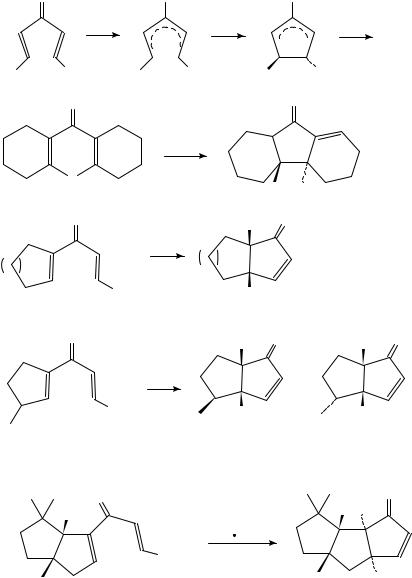
11. Intramolecular cyclization of dienes and polyenes |
509 |
subsequent aqueous work-up (equation 8). In the cyclization of the cyclopentene derivatives 11, the silyl moiety exerts a remote stereocontrol: the isomers 12 and 13 are formed in the ratios 54:46, 62:38, 76:24 and 79:21 as the silyl group varies from SiMe3 to SiMePh2, SiPh3 and Si(Pr-i)3 (equation 9)9.
|
O |
|
OH |
|
OH |
|
|
|
+ H |
+ |
+ |
|
+ |
|
Products |
|
|
|
|
|
|||
R1 |
R2 |
R1 |
R2 |
R1 |
|
R2 |
(6) |
|
|
|
|
|
|
|
|
|
O |
|
|
|
O |
|
|
|
|
|
|
|
|
|
|
|
|
|
H3 PO4 |
|
|
|
(7) |
|
(7) |
|
|
|
(8) |
|
|
|
O |
|
|
H |
O |
|
|
|
|
|
|
|
|
|
|
|
|
|
FeCl3 |
|
|
|
|
|
n |
|
n |
|
|
|
(8) |
|
|
|
|
|
|
|
|
|
|
SiMe3 |
|
H |
|
|
|
|
(9) |
|
|
(10) |
|
|
|
|
O |
|
|
H |
O |
H |
O |
|
|
|
|
|
|
||
|
|
|
FeCl3 |
|
+ |
|
(9) |
|
|
SiR3 |
|
H |
|
H |
|
|
(11) |
|
|
(12) |
|
(13) |
|
The action of boron trifluoride etherate on the ketone 14 results in the tricyclic ketone 15 in 80% yield (equation 10)10.
O |
|
O |
H |
|
H H |
|
|
|
BF3 |
Et2 |
O |
SiMe3 |
|
(10) |
|
|
|
|
|
H |
(14) |
|
(15) |
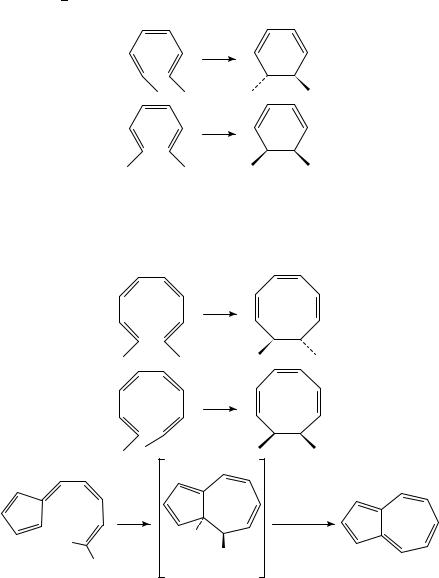
510 |
Gerhard V. Boyd |
The thermal disrotatory cyclization of hexatrienes leads to cyclohexadienes (equations 11 and 12)11 13.
(11)
(12)
The predicted conrotatory cyclization of octatetraenes was confirmed for the case of the methyl-substituted compounds, which above 16 °C readily formed the cyclooctatrienes shown in equations 13 and 14)14. We conclude this section with an electrocyclic reaction involving ten -electrons, that is, the formation of azulene (17) when the fulvene 16 is heated (equation 15)15,16.
(13)
(14)
H |
H |
− HN(Ph)Me |
|
|
|
|
|
|
N(Ph)Me |
N(Ph)Me |
|
|
|
|
|
(16) |
|
(17) |
(15) |
|
|
|
III. A COPE REARRANGEMENT
The ‘Cope ring-expansion’ of trans-1,2-divinylcyclohexane results in 1,5-cyclodecadiene (equation 16); however, the equilibrium favours the monocyclic compound17. In the case of the allene 18, ring-expansion occurs: at 90 °C the methylenecyclodecadiene 19 is formed
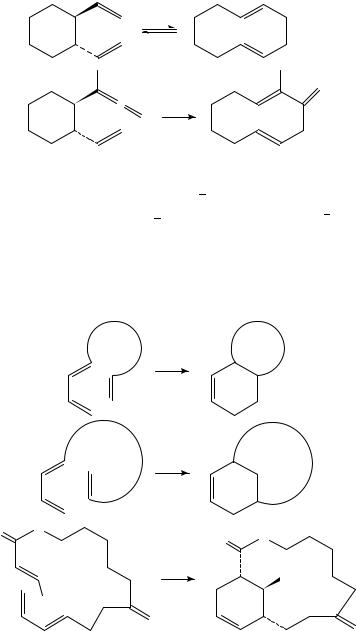
11. Intramolecular cyclization of dienes and polyenes |
511 |
in greater than 99% yield (equation 17)18.
(16)
•
(17)
(18) |
(19) |
IV. INTRAMOLECULAR DIELS ALDER REACTIONS
Several reviews on intramolecular Diels Alder reactions have appeared19 23. The products may be either fused (equation 18) or bridged (equation 19). The vast majority of reported examples of the reaction result in fused products; bridged compounds are rarely observed and only in cases where the diene and dienophile are separated by ten or more carbon atoms, e.g. 20 ! 21 (equation 20)24. The decatriene 22 cyclizes at 200 °C to the trans-fused octalins 23 and 24 (equation 21)25,26. Heating the ester 25 yields a 1:1 mixture of the cis- and trans-octalins 26 and 27 (equation 22)27. The palladacycle
(18)
(19)
O O
O O
CO2 Me
(20)
CO2 Me
(20) |
(21) |
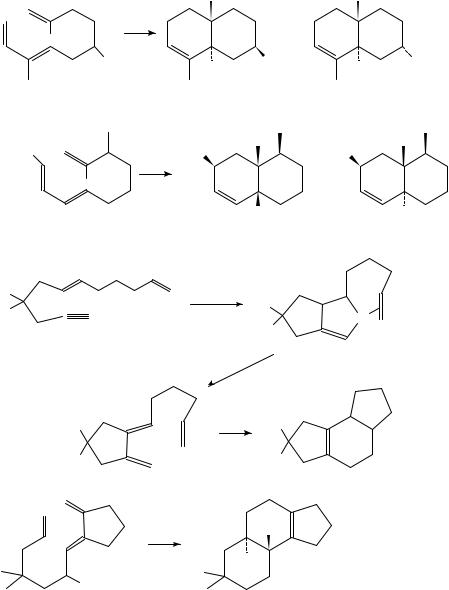
512 |
Gerhard V. Boyd |
29, produced from the dienyne 28 (E D CO2Me) and palladium(II) acetate in boiling toluene, decomposes to the triene 30, which forms the cyclization product 31 in 72% overall yield (equation 23)28. Thermal ring-closure of 32 gives the trans-fused tricyclic alcohol 33 (equation 24)29.
200 ˚C
OSiMe3
(22)
EtO2 C
(25)
E
E
(28)
E
E
(30)
OH
|
+ |
|
H |
OSiMe3 |
H |
|
||
(23) |
|
(24) |
EtO2 C |
|
EtO2 C |
|
|
+ |
|
H |
|
|
(26) |
|
Pd(OAc)2
E
Pd
E
(29)
E
E
(31)
H
H
 OH
OH
OSiMe3
(21)
H
(27)
(22)
(23)
(24)
(32) |
(33) |

11. Intramolecular cyclization of dienes and polyenes |
513 |
A number of stereospecific intramolecular Diels Alder reactions of trienones leading to cis-fused products have been described. The ketone 34 forms solely compound 35 on treatment with aluminium trichloride at 110 °C (equation 25)30. The lower homologue 36 undergoes a spontaneous cyclization to 37 below 20 °C (equation 26)31 and the isomeric ketones 38 and 40 similarly give 3932 and 4133, respectively (equations 27 and 28).
O |
|
O |
|
|
H |
|
A lCl3 |
|
|
110 ° C |
(25) |
|
|
|
|
|
H |
(34) |
|
(35) |
O |
|
O |
|
|
H |
|
|
(26) |
|
|
H |
(36) |
|
(37) |
O |
|
O |
|
|
H |
|
|
(27) |
|
|
H |
(38) |
|
(39) |
O |
|
O |
|
|
H |
(28)
H
(40) |
(41) |
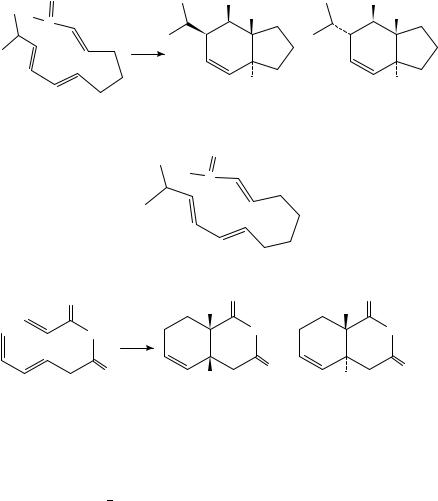
514 |
Gerhard V. Boyd |
The stereoselectivity of the thermal ring-closure of the dodecatrieneones 42 is determined by the nature of the remote group R. trans-Fused products 43 predominate over cis-products 44 and their ratio increases as R varies from MeO through Me to H (equation 29). If the reactions are catalysed by diethylaluminium chloride only trans-compounds are formed. The homologues 45 behave similarly34. In contrast, the 7-azadeca-1,3,9-trienes 46 (X, Y D H2 or O) yield more of the cis- than the trans-fused compounds, regardless of the nature of X and Y (equation 30)35.
O
R
C
(42)
Y
NMe
X
(46)
RCO |
RCO |
H |
H |
|
+ |
H |
H |
(43) |
(44) |
(29)
O
R C
(45)
Y |
Y |
H |
H |
NMe |
NMe |
+ |
(30) |
X |
X |
H |
H |
major |
minor |
The acid-catalysed intramolecular ring-closure of the heptadienylcyclohexenone 47 yields the tricyclic compound 49 via the rearranged intermediate 48, the product of a proton shift (equation 31)36. Similarly, 1,9,11-dodecatrien-3-one (50) gives a mixture containing 94% of 51 and only 6% of the unrearranged product 52 (equation 32)36
ortho-Quinodimethanes possessing a suitably positioned double bond undergo intramolecular Diels Alder reactions spontaneously (equation 33)37. The quinodimethanes have been generated by thermolysis of 3-isochromanones (equation 34)38 by the action of tetrabutylammonium fluoride on o-(1-trimethylsilylhept-6-enyl)benzyltri- methylammonium iodide (equation 35)39 and by heating alkenyl-dihydrobenzo[c]thiophen 2,2-dioxides at 240 °C in diethyl phthalate (equation 36)40. The tricyclic hydrocarbons 53
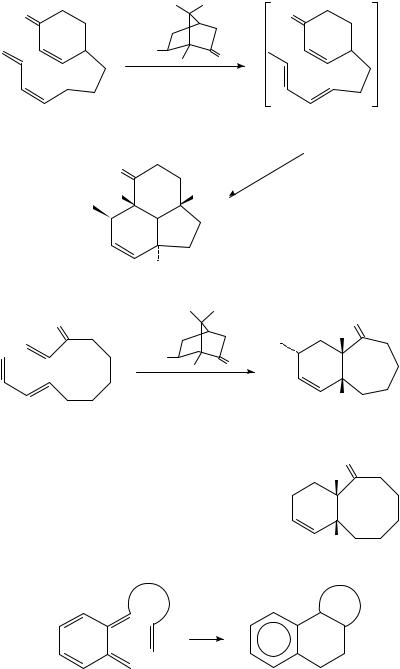
11. Intramolecular cyclization of dienes and polyenes |
515 |
|
O |
O |
|
HO3 |
S |
|
|
O |
|
(47) |
(48) |
(31)
O
H H
 H
H
H
(49)
O O
H
HO3 S
O
H
(50) |
(51) |
(32)
O
H
+
H
(52)
(33)
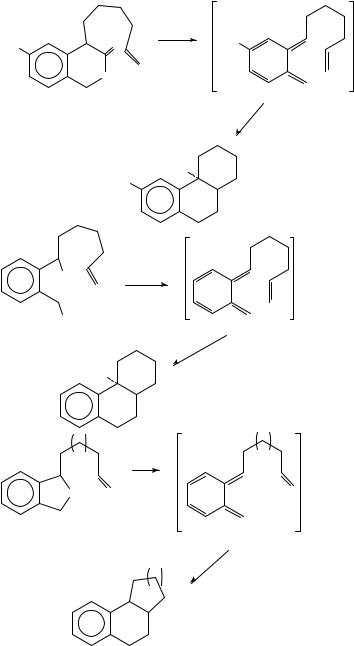
516 |
|
Gerhard V. Boyd |
MeO |
O |
MeO |
−CO2 |
||
|
O |
|
(34)
H
MeO
 H
H
SiMe3 |
|
+ |
− |
|
Bu4 NF |
||
+ |
|
− |
|
NMe3 |
I |
(35) |
|
|
|
|
H
 H
H
n |
n |
−SO2
SO2
(36)
n
(53)
